Question (13 marks)
Some musical instruments, such as the guitar, make sounds by vibrating strings.
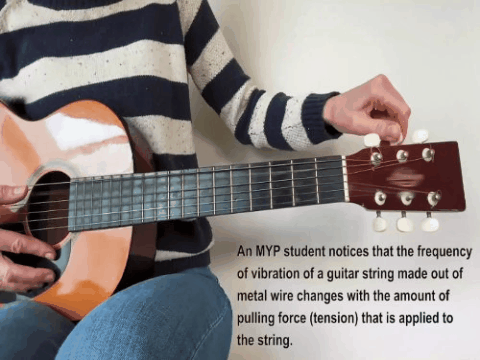
Question a (2 mark)
The student’s research question is:
How does increasing the force of tension affect the frequency of vibration of a wire?
Suggest two variables the student should have controlled during this investigation.
Control variable 1:
Control variable 2 :
▶️Answer/Explanation
Ans:
Control variable 1: Length of the string
Control variable 2 : thickness / diameter of the string
Question b (4 mark)
The student’s notebook containing the results from this investigation is shown below:
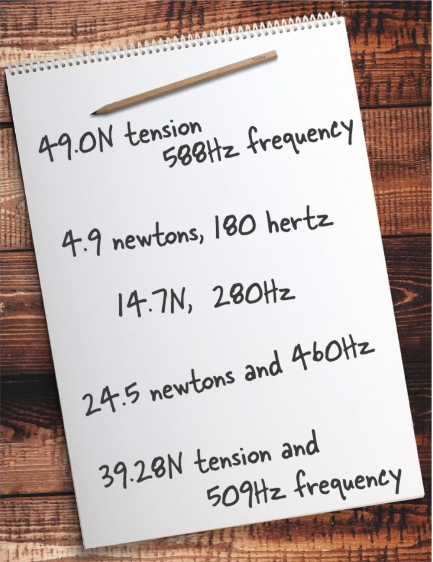
Organize and present the data in a table.
▶️Answer/Explanation
Ans:
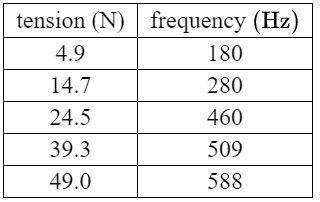
Question c (2 mark)
The student plots a graph of frequency against tension for their results.
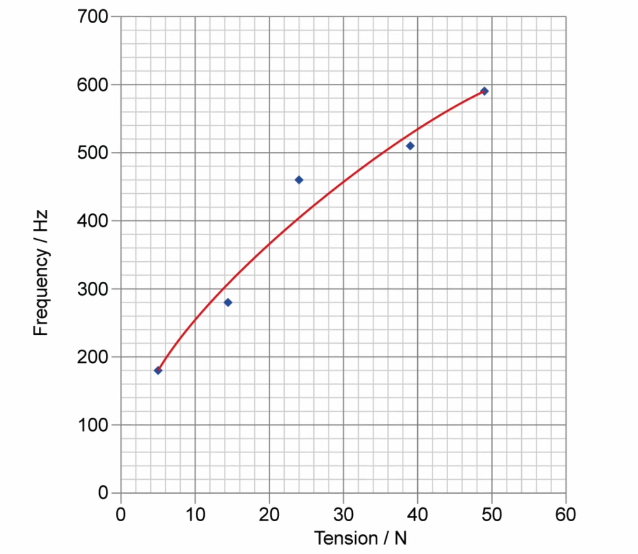
The student makes the following statement:

Suggest what additional measurements the student should make to verify the relationship shown by the graph. Justify your answer.
▶️Answer/Explanation
Ans:
Question d (3 mark)
Many different investigations can be carried out relating to the frequency of vibration of a wire. Identify the variables for a new investigation with frequency as the dependent variable.
Independent variable:
Dependent variable:
▶️Answer/Explanation
Ans:
Independent variable: length of the string
Control variable 1: thickness of the string
Dependent variable: Frequency
Control variable 2 : nature of the material of string
Question e (2 mark)
Formulate a hypothesis for the new investigation in part (e).
If:
Then:
▶️Answer/Explanation
Ans:
If: the length of the string is increased
Then: frequency of the sound will decrease
Because: speed of wave $=$ frequency $\times$ wavelength
wavelength of sound wave is equal to twice the length of the string. So, as the length of the string increases, wavelength of sound also increases. This means that the frequency decreases (as speed of wave is nearly constant).
Question (17 marks)
The loudness of a sound relates to its intensity level. The sound intensity level can be measured in decibels (dB) using an instrument known as a sound level meter.
A sound level meter was used to investigate the relationship between sound intensity level and distance from the sound source. The investigation was performed on a school field using a speaker and three trials were carried out at each distance.
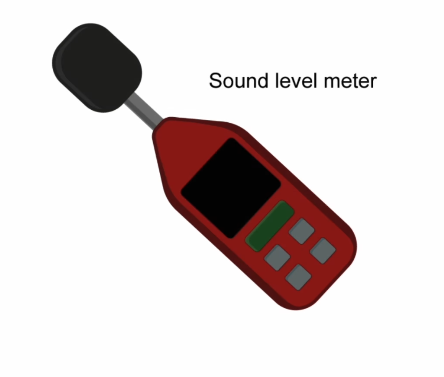
Question a (1 mark)
Suggest why three trials were carried out during data collection.
▶️Answer/Explanation
Ans:
Question b (2 mark)
The equipment below to measure the sound intensity level at a distance of $6 \mathrm{~m}$ from the speaker. Calculate the average sound intensity level and add your value to the table.
$\text{Diagram not to scale}$
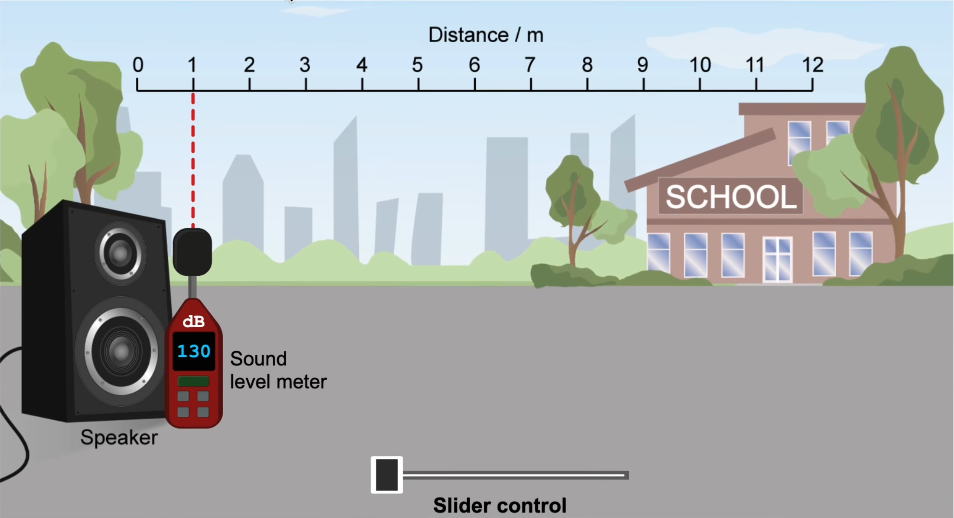
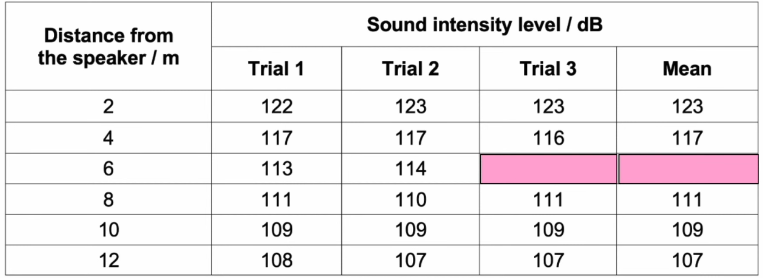
▶️Answer/Explanation
Ans:
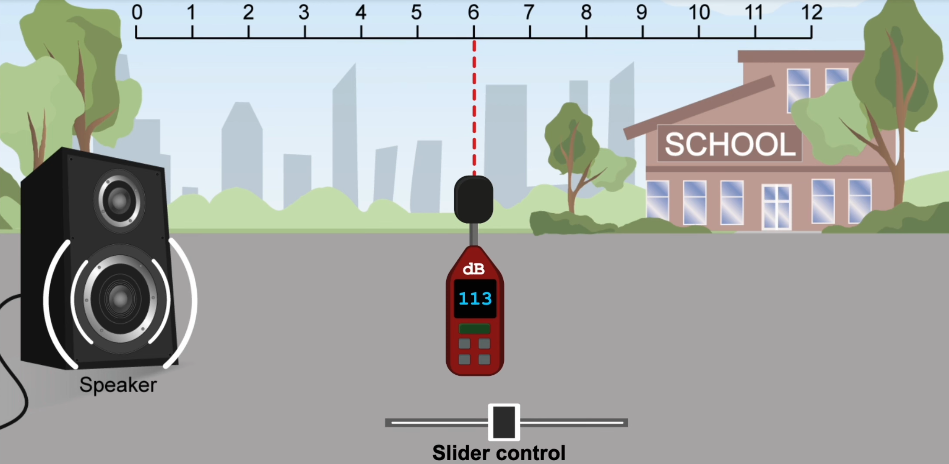
On $6 \mathrm{~m}$ from the speaker sound intensity level is showing $113\rm{dB}$
taking average value $\frac{(113+114+113)}{3} \quad=113.3333333$
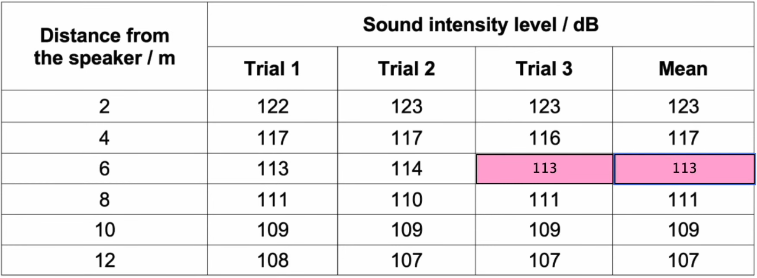
Question c (1 mark)
A simple pattern that can be seen in the data is that a doubling of the distance changes the sound intensity level by the same amount. Use this pattern to predict the sound intensity level at a distance of $16 \mathrm{~m}$.
▶️Answer/Explanation
Ans:
Question d (13 mark)
An MYP student is interested in how the thickness of a wall affects the sound intensity level that is measured on the other side of the wall.
They make the model that is shown below to use in their investigation.
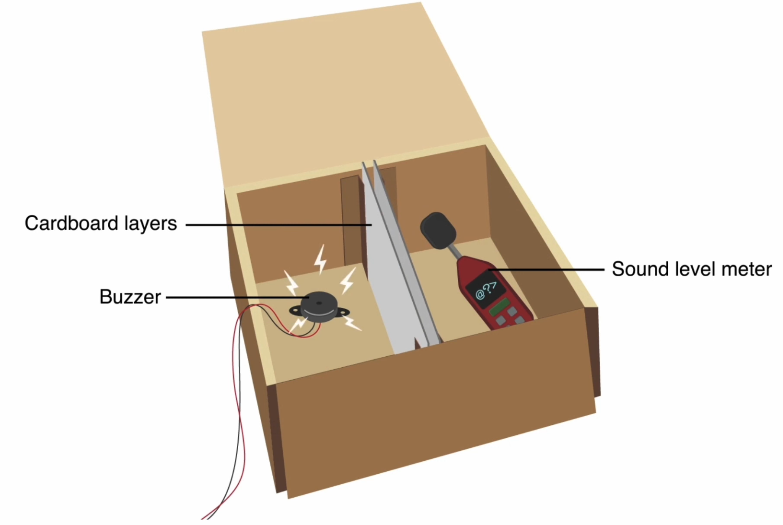
On one side of the wall they will have a buzzer and on the other side of the wall they will have a sound level meter.
Design an investigation to find out how the number of layers of cardboard in the wall affects the sound intensity level. In your plan, you should include:
your independent and dependent variables and the justification of two control variables
- a hypothesis which is explained using scientific reasoning
- a detailed method for how you will collect data
- an explanation of how you will collect sufficient data.
▶️Answer/Explanation
Ans:
independent variable: the number of layers of cardboard in the wall dependent variable: the sound intensity level (in $\mathrm{dB}$ ) on the other side of the wall using sound level meter.
control variable 1: The source of the sound (the buzzer) should remain the same throughout the experiment. This can be achieved by using the same buzzer with the same power output for each trail.
control variable 2: The position of the sound level meter should be the same for each trial. This can be achieved by placing the sound level meter at the same distance and angle from the wall for each trail.
Hypothesis: As the number of cardboard in the wall increases, the sound intensity level on the other side of the wall will decrease. This is because each layer of cardboard will absorb some of the sound energy, reducing the intensity of the sound that passes through the wall.
Method and Data Collection:
1. Gather materials: Cardboard, buzzer, sound level meter, ruler and tape.
2. Set up the buzzer on one side of the wall and the sound level meter on the other side of the wall.
3. Place one layer of the cardboard on the wall between the buzzer aritd the sound level meter. Measure the distance between the sound level meter and the wall and ensure that the sound level meter is positioned perpendicular to the wall.
4. Turn on the buzzer and record the sound intensity level on the other side of the wall using the sound level meter.
5. Repeat step 4 for $2,3,4$ and 5 layers of cardborad.
6. Repeat steps 3-5 three times for each number of cardboard layers to ensure accuracy.
7. Calculate the average sound intensity level for each number of cardboard layers.
At last, plot the results on a graph to visulaize the relationship betweeen the number of cardboard layers (x-axis) and the sound intensity level in $\mathrm{dB}$ (y-axis).
Question (7 marks)
Question a (1 mark)
Transformers are electrical devices that are used for reducing or increasing the voltage of an alternating current.
Select the correct terms to complete the sentence.
In a transformer that is $100 \%$ efficient, the input ______________ must be ___________________ the output power.
▶️Answer/Explanation
Ans:
In a transformer that is $100 \%$ efficient, the input power must be equal to the output power.
Question b (2 mark)
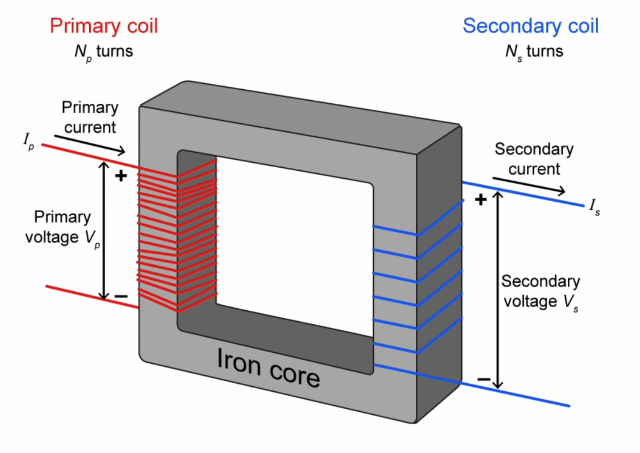
Transformers are commonly used to reduce the voltage from supply lines to the voltage required for homes.

Use information from the formula sheet to calculate the primary supply voltage. You should assume this transformer is $100 \%$ efficient.
▶️Answer/Explanation
Ans:
Power Primary = Power Seconday
$\mathrm{Vp}~\rm I\mathrm{p}=\mathrm{Vs}~\rm I \mathrm{s}$
$$
\begin{aligned}
& \frac{\rm V p}{\rm V s}=\frac{\rm I s}{\rm I p} \\
& \rm V_ p=\frac{I s \times \rm V s}{\rm I p} \\
& \rm V p=\frac{(240 \times 60)}{1.2}=12000 \\
& \rm V p=12000 \mathrm{~V}
\end{aligned}
$$
Question c (2 mark)
In reality, transformers are only $98 \%$ efficient. Calculate the actual power supplied by the secondary coil.
▶️Answer/Explanation
Ans:
Power Primary $=\rm Vp \rm Ip$
Power Primary $=12000 \times 1.2$
Power Primary $=14400$
transformers are only $98 \%$ efficient, therefore.
actual power supplied by the secondary coil $=0.98 \times 14400$
actual power supplied by the secondary coil is $14112 \mathrm{~W}$
Question d (2 mark)
The relationship between power and current can be expressed as $P=I^2 R$ where $P=$ power, $I=$ current and $R=$ resistance. Use this relationship to describe why electricity is transmitted over long distances at high voltage.
▶️Answer/Explanation
Ans:
When electricity is transmitted over long distances, the resistance of the transmission lines causes a loss of power in the form of heat. This power loss is given by the formula $P=I^2 R$, where $I$ is the current flowing through the transmission line and $R$ is the resistance of the line. Therefore, for a given power level, a higher current will result in a higher power loss.
To minimize power loss during transmission, the voltage of the electricity is increased. This reduces the current flowing through the transmission lines for a given power level, according to Ohm’s law, $V=IR$, where $V$ is the voltage. As a result, the power loss is reduced according to the formula $P=I^2 R$.
Therefore, transmitting electricity at high voltage and low current is more efficient, as it results in less power loss during transmission. To use high voltage, transformers are used to increase the voltage for long distance transmission and decrease it for distribution to homes and businesses.
Question (16 marks)
This question is about the generation and transmission of electricity. In many developed countries, electricity is generated in large power stations, far away from where the people who use the electricity live and work.
The energy sources that power the generators in large industrial countries are coal, gas and nuclear (fission) reactors, or a mix of these.
Question a (2 mark)
Suggest two reasons why people would not want a coal-fired power station in or near their city.
Reason 1:
Reason 2:
▶️Answer/Explanation
Ans:
Reason 1: Environmental Impact – Coal-fired power stations are known to be significant contributors to air pollution and greenhouse gas emissions. The burning of coal releases pollutants such as sulfur dioxide, nitrogen oxides, and particulate matter, which can have detrimental effects on air quality and human health. These emissions are associated with respiratory problems, cardiovascular diseases, and other health issues. Additionally, coal combustion releases carbon dioxide, a major greenhouse gas that contributes to climate change. People may not want a coal-fired power station near their city due to concerns about the negative impact on local air quality, public health, and the environment.
Reason 2: Local Environmental and Social Disruption – Coal mining, which is often required to supply coal to power stations, can have severe local environmental and social impacts. Surface mining methods, such as mountaintop removal, can result in deforestation, soil erosion, and the destruction of natural habitats. Underground mining can lead to ground subsidence and water pollution from mine drainage. Communities near coal mines may also experience disruptions and health risks associated with mining operations, such as noise, dust, and potential water contamination. People may oppose a coal-fired power station in or near their city due to concerns about the local environmental disruption caused by coal mining activities and its potential consequences for their well-being and quality of life.
Question b (1 mark)
Outline a reason why coal-fired and nuclear power stations are built near large rivers or the sea.
▶️Answer/Explanation
Ans:
Reason: Water for Cooling – Coal-fired and nuclear power stations require a significant amount of water for cooling purposes. Building these power stations near large rivers or the sea provides easy access to a reliable water source for cooling the power generation process.
Question c (1 mark)
The cables lose some electrical power as it transfers from the power station to the city. One solution is to reduce this power loss by increasing the voltage of the electricity in the cables when the energy travels long distances.
A transformer converts current and voltage.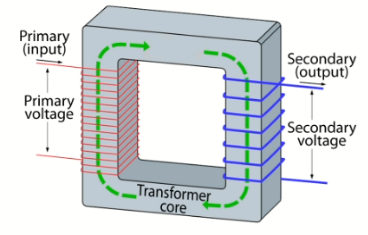
For an ideal transformer, the primary (input) power equals the secondary (output) power.
If $\rm{P=IV}$, when the secondary voltage doubles, state what happens to the secondary current.
▶️Answer/Explanation
Ans:
When the secondary voltage of an ideal transformer doubles, the secondary current will be halved.
Question d (3 mark)
Describe why increasing the voltage reduces the power lost during transmission.
▶️Answer/Explanation
Ans:
Increasing the voltage reduces the power lost during transmission for the following reasons:
1. Reduced $\rm {I^2R}$ Losses: Power loss in a transmission line is primarily caused by resistance (R) in the cables, resulting in $\rm {I^2R}$ losses. By increasing the voltage, the current (I) can be reduced for a given amount of power (P). Since power loss is proportional to the square of the current ($\text{P}_{\text{loss}} =\rm{I^2R}$), reducing the current significantly reduces the $\rm {I^2R}$ losses. Therefore, increasing the voltage helps minimize power losses due to resistance in the transmission lines.
2. Reduced Transmission Line Losses: Transmission lines have inherent capacitance and inductance, which cause power losses through various phenomena like capacitive and inductive reactance. These losses, known as reactive power losses, can be significant in long-distance power transmission. Increasing the voltage allows for better control of reactive power flow, reducing the reactive power losses in the transmission lines.
3. Increased Efficiency: As power is transmitted over long distances, the power loss can be substantial if the voltage is not properly managed. Higher transmission voltages allow for more efficient power transfer, resulting in a smaller proportion of power lost during transmission. By reducing the power losses, higher voltage transmission systems improve the overall efficiency of the electrical grid, ensuring that a greater proportion of the generated power reaches its intended destination.
In summary, increasing the voltage during transmission reduces power losses by minimizing $\rm {I^2R}$ losses, mitigating reactive power losses, and improving the overall efficiency of power transfer in the electrical grid.
Question e (6 mark)
Coal is a source of energy that is found in many parts of the world. When coal is burned, it produces three gases: water vapour $\left(\mathrm{H}_2 \mathrm{O}\right)$, carbon dioxide $\left(\mathrm{CO}_2\right)$ and sulfur dioxide $\left(\mathrm{SO}_2\right)$.
Choose any two of the gases listed above and describe a problem associated with each.
Select gas…………..
Problem…………….
How does this gas cause this problem………..?
▶️Answer/Explanation
Ans:
Gas 1: Carbon Dioxide $(\left(\mathrm{CO}_2\right))$
Problem: Climate Change
How does this gas cause this problem: Carbon dioxide is a greenhouse gas that contributes to the phenomenon of climate change. When coal is burned, it releases carbon dioxide into the atmosphere. The accumulated carbon dioxide traps heat from the sun within the Earth’s atmosphere, leading to a rise in global temperatures. This increase in temperature disrupts ecosystems, causes sea level rise, intensifies extreme weather events, and poses risks to human health and well-being. The excessive release of carbon dioxide from burning coal contributes to the overall increase in greenhouse gas concentrations and exacerbates the issue of climate change.
Gas 2: Sulfur Dioxide $(\left(\mathrm{SO}_2\right))$
Problem: Air Pollution and Acid Rain
How does this gas cause this problem: When coal with a high sulfur content is burned, it emits sulfur dioxide into the air. Sulfur dioxide is a harmful air pollutant that can have significant environmental and health impacts. It reacts with other substances in the atmosphere to form fine particulate matter, which can contribute to the deterioration of air quality. When these particles are inhaled, they can cause respiratory problems, aggravate existing respiratory conditions, and have adverse effects on cardiovascular health.
Moreover, sulfur dioxide can combine with atmospheric moisture to form sulfuric acid, leading to the formation of acid rain. Acid rain has detrimental effects on ecosystems, including the acidification of lakes, rivers, and soils. It can harm aquatic life, damage vegetation, and contribute to the degradation of buildings and infrastructure. The release of sulfur dioxide from coal combustion thus contributes to air pollution and the formation of acid rain, impacting both human health and the environment.
Question f (10 mark)
Large power stations operate continuously, 24 hours a day, and it often takes many days to turn them on and off.
Suggest why a power generation company might sell electricity more cheaply at night than during the day.
▶️Answer/Explanation
Ans:
A power generation company might sell electricity more cheaply at night than during the day for the following reasons:
1. Reduced Demand: During nighttime, there is typically a decrease in electricity demand compared to the daytime. Industries, businesses, and many residential consumers tend to consume less electricity during non-peak hours, such as late at night or early morning. As a result, the overall demand for electricity is lower during these periods. To encourage utilization and prevent excess supply, power generation companies may lower the electricity prices during the night when the demand is relatively lower.
2. Off-Peak Generation Capacity: Power stations have a certain capacity for generating electricity, which is often more than what is required during periods of low demand. During nighttime, when electricity demand is lower, the power generation company may have surplus generation capacity that is not fully utilized. In such cases, they might offer electricity at a lower price to incentivize consumers to use electricity during off-peak hours and make better use of the available generation capacity.
3. Operational Efficiency: Operating large power stations continuously allows for better operational efficiency and reduces the costs associated with starting up or shutting down the power station. It takes time and resources to ramp up or shut down the generation processes, which can be more expensive and less efficient than maintaining a steady operation. By offering electricity at a lower price during the night, power generation companies can encourage the utilization of their continuous generation capacity, maximizing operational efficiency and minimizing the need for frequent startup or shutdown procedures.
In summary, a power generation company may sell electricity more cheaply at night due to reduced demand, surplus generation capacity during off-peak hours, and the desire to maintain operational efficiency by avoiding frequent startup or shutdown processes.
Question (16 marks)
A pan flute is a musical instrument made from hollow tubes that are closed at one end. The tubes are commonly made from natural materials, such as bamboo. The tubes are cut to different lengths. When air is blown across a tube, the air vibrates and produces a sound.

Question a (1 mark)
An MYP student is interested in the relationship between the length of a tube and the frequency of the sound being produced.
State a research question that would be tested by this investigation.
▶️Answer/Explanation
Ans:
Question b (3 mark)
You are provided with a box of tubes. Select the tubes you would use in the investigation in part (a) to collect appropriate data. Drag your selected tubes from the top box of available tubes into the bottom box.

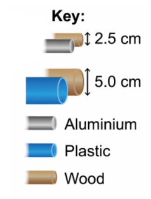
▶️Answer/Explanation
Ans:

Question c (2 mark)
Justify the selection you made in part (b).
▶️Answer/Explanation
Ans:
Question d (3 mark)
A student doing a similar investigation made the following prediction:

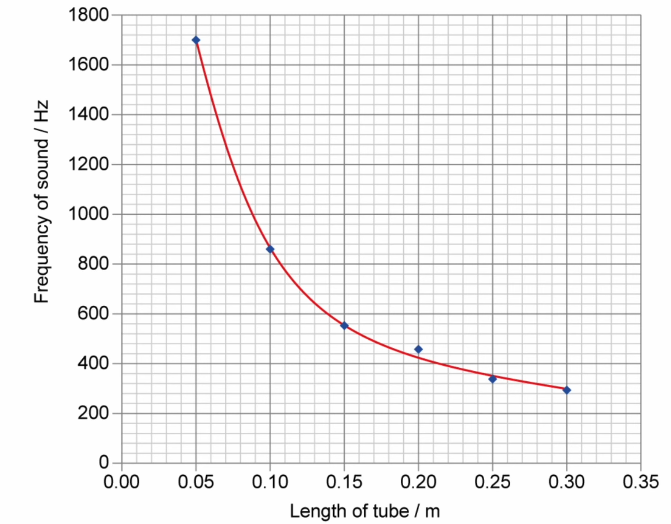
Use data from the graph and a calculation to explain whether the student’s prediction is supported.
▶️Answer/Explanation
Ans:
For an inverse relationship, the variables $(x, y)$ should follow i.e, $x \times y=$ constant
from the above graph, selecting any two sets of data, i.e $(0.075,1200)$ and $(0.20,425)$ and $(0.3$, 300)
$
0.075 \times 1200=90
$
and
$
0.20 \times 425=85
$
and
$
0.3 \times 300=90
$
So, the hypothesis is correct as per the data.
Question e (1 mark)
This data can be used to find the speed of sound in air using the relationship:
$$
f=\frac{v}{4 L}
$$
Where:
$f$ – frequency
$L$ – length of the tube
$v$-speed of sound in air
Determine the missing values and add them to the table of processed data below.

▶️Answer/Explanation
Ans:
$$
4 \mathrm{~L}=0.4
$$
and $\frac{1}{4}\mathrm{~L}=2.5$

Question f (2 mark)
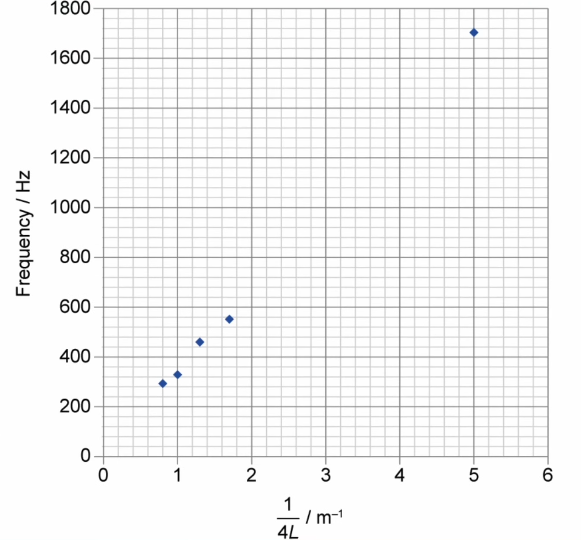
▶️Answer/Explanation
Ans:
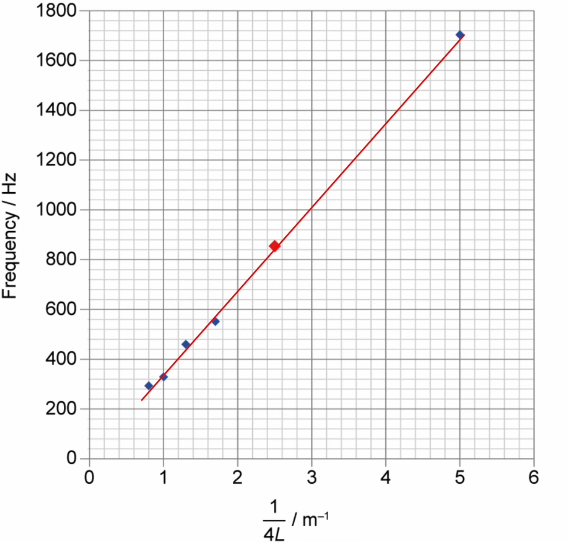
Question g (1 mark)
The student is investigating the relationship $f=\frac{V}{4 L}$. Identify what quantity is shown by the gradient of the graph in part (f).

▶️Answer/Explanation
Ans:

Question h (3 mark)
Calculate the gradient of your line of best fit. You should include your working and state the unit.
▶️Answer/Explanation
Ans:
gradient $=\frac{(1680-330)}{(5-1)}=337.5$
gradient $=337.5 \mathrm{~ms}^{-1}$
Question (16 marks)
The animation below shows a sustainable solution to traffic management in an African city.
Question a (1 mark)
Apart from traffic lights, suggest a different application where a constant source of electricity is necessary.
▶️Answer/Explanation
Ans:
Telecommunication Towers: Cellular towers and communication infrastructure require a continuous power supply to ensure uninterrupted communication services. These towers facilitate wireless connectivity for mobile phones, internet access, and other communication services, and they rely on a stable electricity source for consistent operation.
Question b (15 mark)
Using information from the animation and your wider MYP studies, discuss and evaluate the use of a small-scale solar electrical power supply to solve the problem identified in part (a). In your answer you should consider:
- why a constant source of electricity is important in your application
- the advantage of using a small-scale power supply in this situation
- the disadvantage of using a small-scale power supply in this situation
- economic factors
- social factors.
▶️Answer/Explanation
Ans:
A small-scale solar electrical power supply can be an effective solution to address the problem of insufficient electricity supply and potential traffic chaos due to load shedding. Let’s evaluate its use in terms of the provided criteria:
Constant Source of Electricity:
A constant source of electricity is crucial for traffic lights to ensure proper traffic management and safety. Traffic lights need a reliable power supply to function consistently and provide clear signals to motorists, pedestrians, and cyclists. Interruptions in the power supply can lead to confusion, accidents, and traffic congestion, compromising road safety. Therefore, maintaining a constant source of electricity is essential for the effective operation of traffic lights.
Advantages of a Small-Scale Power Supply:
1. Energy Independence: By using a small-scale solar electrical power supply, the traffic lights become less reliant on the main power grid. Solar panels can harness energy from the sun, providing a renewable and sustainable source of electricity. This reduces dependence on conventional power sources and helps mitigate the effects of load shedding or power outages in the main grid.
2. Environmental Benefits: Solar power is a clean and renewable energy source. By utilizing solar energy for the traffic lights, carbon emissions and pollution associated with conventional energy generation are reduced. This aligns with sustainability goals and helps mitigate climate change and environmental degradation.
Disadvantages of a Small-Scale Power Supply:
1. Dependence on Sunlight: Small-scale solar power systems rely on sunlight to generate electricity. During cloudy or rainy periods, the availability of solar energy may be reduced, potentially affecting the consistent operation of the traffic lights. Adequate energy storage systems, such as batteries, are necessary to store excess energy for use during periods of low sunlight.
Economic Factors:
1. Initial Cost: Implementing a small-scale solar electrical power supply system involves upfront costs, including the purchase and installation of solar panels, batteries, and associated equipment. These costs may be higher compared to traditional grid-powered traffic lights. However, it is important to consider the long-term cost savings from reduced electricity bills and maintenance expenses associated with solar power.
2. Long-Term Cost Benefits: Solar power is a renewable energy source, and once installed, the ongoing operational costs are minimal. With proper maintenance, solar panels have a long lifespan, resulting in long-term cost savings compared to conventional electricity sources.
Social Factors:
1. Community Perception: The use of solar power for traffic lights can contribute to positive community perception, as it demonstrates a commitment to renewable energy and environmental sustainability. It can also raise awareness about the benefits of clean energy sources and inspire further adoption of renewable technologies.
2. Reliability and Safety: The reliability of the small-scale solar power supply system is crucial to ensure continuous operation of the traffic lights. Regular maintenance and monitoring are necessary to address any potential issues promptly. Safety measures must be in place to prevent theft or damage to the solar panels and battery storage systems.
In conclusion, the use of a small-scale solar electrical power supply for traffic lights offers advantages such as energy independence, environmental benefits, and long-term cost savings. However, it also faces challenges related to dependence on sunlight and the initial investment costs. Economic factors such as upfront expenses and long-term savings, as well as social factors including community perception and safety considerations, need to be carefully evaluated when implementing such a solution.
Question
Animals use infrasound as the waves travel long distances. This is because low frequency, long wavelength infrasound waves lose little energy in transmission.

Elephants can communicate with each other using infrasound. Explain how the group of elephants on the other side of the hill can hear the elephant.
▶️Answer/Explanation
Ans:
1. Infrasound travels long distances: Infrasound waves have low frequencies and long wavelengths, allowing them to propagate over long distances without losing much energy. This enables elephants to communicate with each other even if they are located on the other side of a hill.
2. Hill acts as a natural barrier: Although the hill may obstruct the direct line of sight between the elephants, it doesn’t impede the transmission of infrasound waves. Infrasound waves can diffract around obstacles like hills, allowing the sound to reach the other side.
3. Elephant’s sensitive hearing: Elephants have highly sensitive hearing that is adapted to detect and interpret infrasound. Their ears are capable of picking up low-frequency sounds, and their auditory system is specialized for processing infrasound signals. This enables the group of elephants on the other side of the hill to perceive and respond to the communication from the elephant.
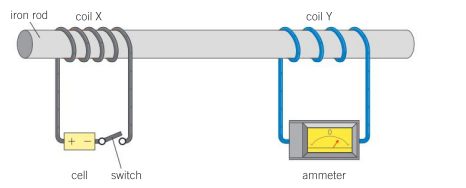
Question:
Explain why the ammeter registers a current when the switch is first closed, but after a short time, the current reading returns to zero.
▶️Answer/Explanation
Ans: When the switch is closed, the magnetic field changes so a current is induced in coil Y
Question:
Describe the reading on the ammeter when the switch is opened again.
▶️Answer/Explanation
Ans: There is a change in magnetic field so a current is induced. This causes the ammeter to jump to the left.
Question:
The iron rod is replaced with a wooden one. Explain what the difference in the induced current would be.
▶️Answer/Explanation
Ans: This would weaken the magnetic field around coil X. The change in magnetic field would be smaller when the switch is closed, causing the induced current in coil Y to be reduced.
Question:
The number of turns in the wire in coil X is doubled. Explain why the ammeter reading is greater when the switch is closed.
▶️Answer/Explanation
Ans: This would strengthen the magnetic field around coil X. The change in magnetic field would be greater when the switch is closed, causing the induced current in coil Y to increase.
Question:
Give one other way in which the ammeter reading could be increased.
▶️Answer/Explanation
Ans: For example, increase the voltage of the cell.
Measuring voltage
The two graphs show the voltage output from a mains power supply (left) and from a battery (right).
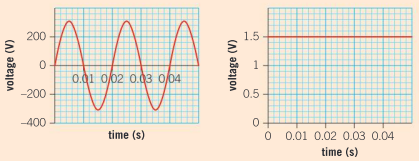
Question:
What is the peak voltage from the mains supply?
▶️Answer/Explanation
Ans: 310 V (±20 V)
Question:
Use the graph to calculate the frequency of the mains voltage.
▶️Answer/Explanation
Ans: \(T = 0.02 s; f=\frac{1}{0.02}=50 Hz\)
Question:
Explain which of these electricity supplies is the more dangerous.
▶️Answer/Explanation
Ans: The mains (a.c.) is more dangerous as the peak voltage is higher.
Question:
A transformer has 20 turns on its secondary coil and a primary coil of 100 turns that is connected to a voltage of 30V.
a) Is this a step-up or step-down transformer?
▶️Answer/Explanation
Ans: Ensure that the combustion reaction has a constant supply of oxygen.
b) Calculate the voltage of the secondary coil.
▶️Answer/Explanation
Ans: \(30\times \frac{20}{100}=6 V\)
Question:
In an experiment, a student wants to use a transformer to convert a primary voltage of 3V a.c. to a secondary voltage of 10V a.c. They have coils with 100, 150, 200, 500, 1,000, 1,500 and 2,000 turns available to make into the transformer.
a) Which coils should they use?
▶️Answer/Explanation
Ans: \(\frac{N_{p}}{N_{s}}must equal\frac{3}{10}\)
so 150 and 500 should be used.
b) What is the largest and smallest voltage they could generate with these coils?
▶️Answer/Explanation
Ans: Largest voltage \(=3\times \frac{2000}{100}=60 V\)
Smallest voltage \(=3\times \frac{100}{2000}=0.15 V\)
c) Why would this not work with a d.c. voltage?
▶️Answer/Explanation
Ans: d.c. will not have a changing current and so no changing magnetic field is produced and no voltage is induced.
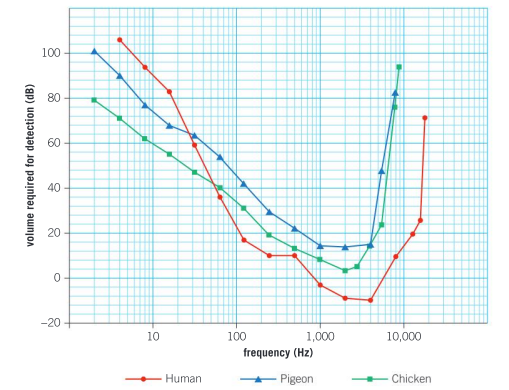
Question:
Which animal is best able to hear sounds at:
a) 10Hz
▶️Answer/Explanation
Ans: Chicken
b) 1kHz?
▶️Answer/Explanation
Ans: Human
Question:
The frequency range of hearing is usually taken to be the range of frequencies that can be heard below a volume of 60dB. Find the hearing ranges of:
a) a chicken
▶️Answer/Explanation
Ans: 10 – 7,000 Hz
b) a pigeon
▶️Answer/Explanation
Ans: 30 – 6,000 Hz
c) a human.
▶️Answer/Explanation
Ans: 20 – 18,000 Hz
Question:
Which animal seems to exhibit:
a) the most sensitive hearing
▶️Answer/Explanation
Ans: Human
b) the most sensitivity to low frequency sounds
▶️Answer/Explanation
Ans: Chicken
c) the most sensitivity to high frequency sounds?
▶️Answer/Explanation
Ans: Human
Question:
The paper presents data on the hearing ranges of chickens. To produce this graph, the authors needed to use data from other studies so they could compare chickens to pigeons and humans. They referenced their sources of data in a bibliography.
a) Explain why it is important for the authors to reference their sources.
▶️Answer/Explanation
Ans: Gives credit to the authors of the sources; allows data/facts to be checked.
b) Write a suitable bibliography reference for this paper.
▶️Answer/Explanation
Ans: A suitable reference in line with your school’s referencing policy. For example: Hill, E. M., Koay, G., Heffner, R. S. and Heffner, H. E. 2014. Audiogram of the chicken (Gallus gallus domesticus), Journal of Comparative Physiology, Pages 863-870.
Question:
Calculate the wavelength of the ultrasound.
▶️Answer/Explanation
Ans: \(\frac{1500}{2.5\times 10^{6}}=6\times 10^{-4}m\)
Question:
The image is built up by sending ultrasound waves and measuring the time between the emission of the waves and the detected echo. If the waves bounce off an object that is 3cm away from the transducer, what is the time delay between the ultrasound wave being emitted and the echo being received?
▶️Answer/Explanation
Ans: \(\frac{0.03}{1500}=2\times 10^{-5} s; 2\times 2\times 10^{-5}=4\times 10^{-5}s\)
Summative assessment
Uses of electromagnetism in car design
Electromagnetic induction can be used in the braking system of cars. By using the motor as a generator, the energy of the moving car can be used to drive the generator and the current that is produced can charge a battery or be used in other ways by the car. Such a system is called regenerative braking.
Question:
Describe the way an electric motor works.
▶️Answer/Explanation
Ans: Accept 4 from: electric motor has a coil of wire with a current running through it; coil is placed in a magnetic field; the current in the magnetic field experiences a force; opposite sides of coil have current flowing in opposite directions; forces on each side act in opposite directions; creates a turning force; a commutator is used to reverse the direction of current every half turn of the coil.
Question:
Explain why operating a motor in reverse can generate an electric current.
▶️Answer/Explanation
Ans: Operating a motor in reverse causes the coil to rotate; as the coil turns, it cuts through the magnetic field lines; when a conductor cuts through magnetic field lines, a voltage is induced; induced voltage can cause a current to flow.
The velocity–time graph of a car braking is shown here.
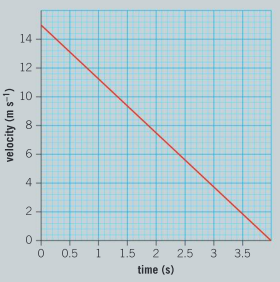
Question:
Use the graph to determine:
a) the deceleration of the car
▶️Answer/Explanation
Ans: Gradient = 3.75 m s–2
b) the distance traveled in this time.
▶️Answer/Explanation
Ans: Area under graph \(=\frac{15\times 4}{2}=30 m\)
Question:
If the car has a mass of 1,000kg, calculate the braking force applied to the car.
▶️Answer/Explanation
Ans: 1,000 × 3.75 = 3,750 N
Question:
Calculate the work done by the brakes on the car.
▶️Answer/Explanation
Ans: 3,750 × 30 = 113 kJ
Using regenerative brakes
Engineers designing a braking system for an electric car want to test the current that the system generates. They drive a car which is fitted with this braking system at different speeds, brake, then measure the voltage generated.
Question:
Identify the independent and dependent variables in this experiment.
▶️Answer/Explanation
Ans: Independent variable – speed
Dependent variable – voltage generated
Question:
As an improvement to the experiment, the engineers realize that when they brake they can monitor the speed of the car as it slows down and the voltage generated by the braking system at the same time. Describe one advantage of using this method.
▶️Answer/Explanation
Ans: Allow one for an advantage and one for the explanation. For example, the method allows for more data to be taken as for each run, many different speeds can be investigated.
Two graphs of their results are shown below.
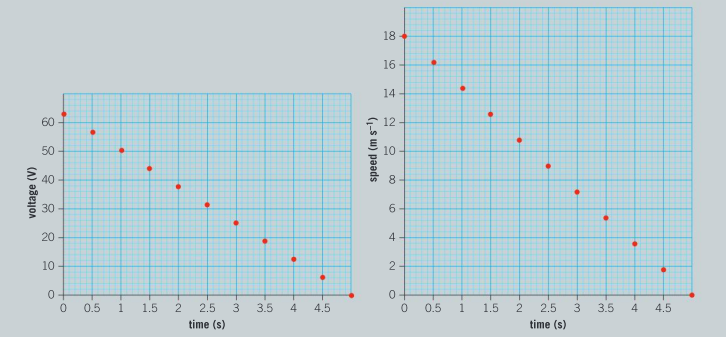
Question:
Using the graphs, deduce what voltage would be generated at a speed of 30km h−1.
▶️Answer/Explanation
Ans: \(30 km h^{-1}=\frac{30000}{3600}=8.33 ms^{-1};\)
from graph, when speed = 8.33 m s–1, t = 2.7s; use time to read value off voltage graph; at 2.7 s, V = 29 V
Question:
The maximum voltage that the braking system could deliver without damaging the battery is 60V. What is the maximum speed at which this braking system could be used?
▶️Answer/Explanation
Ans: Use graph to read time; at 60V, time is 0.25 s; read second graph; at 0.25 s, speed = 17 m s–1
Question:
The engineers who conducted this experiment formulated a hypothesis that the voltage generated by the braking system would be directly proportional to the speed at which the car is traveling. Determine whether their hypothesis was correct or not.
▶️Answer/Explanation
Ans: Yes – voltage is directly proportional to speed; when speed is doubled, voltage also doubled (backed up by example/calculation); at zero speed, zero voltage is generated.
Question:
The engineers used data-logging equipment to simultaneously measure the speed of the car and the voltage from the braking system. Explain why the measurements needed to be simultaneous.
▶️Answer/Explanation
Ans: Values for time are the same on each graph; need to ensure that voltage and speed can be compared at each time.
Testing electric cars
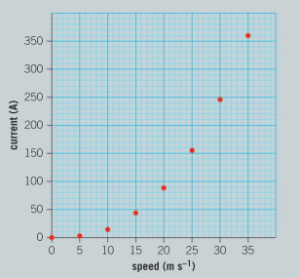
Question:
When testing an electric car, engineers drive it at different speeds and measure the current that the motor draws from the battery at that speed. Their results are shown on the next page.
a) Draw a line of best fit on a copy of the graph.
▶️Answer/Explanation
Ans: Curved line of best fit:
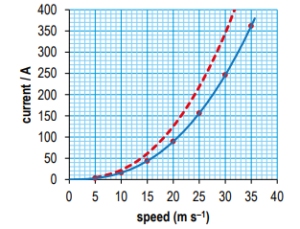
b) Describe the trend of the data.
▶️Answer/Explanation
Ans: Trend is non-linear; as speed increases, current increases at an increasing rate.
c) Suppose the engineers had tested the car on a slight uphill slope. Draw a line on the copy of the graph to show how their results would have differed. Explain your answer.
▶️Answer/Explanation
Ans: As the car is having to do work against gravity, more energy is required; current will be greater; similar curve drawn on graph with points lying above original line (see red-dashed line on graph above).
d) If the maximum current that the battery can deliver is 300A, determine the fastest speed that the car can go on a flat road. Give your answer in kilometers per hour.
▶️Answer/Explanation
Ans: From the graph, when current = 300 A, speed = 32.5 m s–1
\(\frac{32.5\times 60\times 60}{1000}=117 km h^{-1}\)
Question:
A team of engineers is going to test electric cars made by three competing companies and they intend to publish their results. The car companies believe that it is important that the results of the tests are reliable and fair. Explain what the engineers should do to ensure that their results are reliable and fair.
▶️Answer/Explanation
Ans: Up to 5 from:
Reliable: Tests should be repeated; many times; average of results taken.
Fair: Same test; control variables should be kept the same; example of control variable given.
The future of electric cars
Electric cars are an alternative method of transport to petrol- and diesel-powered cars.
Question:
One disadvantage of electric cars is that they are so quiet they are not easily heard. It is argued that this makes them more dangerous to pedestrians. One solution is to connect a loudspeaker to the battery so that the car makes more noise. A scientist on the design team for an electric car points out that the battery is a d.c. supply, so the loudspeaker would not be able to generate a sound. Instead the scientist proposes that a circuit which generates an alternating current at a certain frequency should be used. Write an explanation that the scientist might use to persuade the rest of the design team that a.c. current should be used and suggest a suitable frequency. Try to use simple scientific terms effectively.
▶️Answer/Explanation
Ans: Award marks for quality of explanation. Answer should include: DC current would cause the speaker cone to have a constant displacement – no sound; AC current will oscillate the speaker cone causing a sound; sound should be audible – frequency in audible range; suitable range of frequencies: 100–1,000 Hz.
Question:
Apart from the noise issue, describe one advantage and one disadvantage of electric cars over petrol and diesel cars.
▶️Answer/Explanation
Ans: One mark for each advantage and disadvantage and one mark for an explanation. Examples:
Advantages
- Petrol/diesel cars cause pollution/emit CO2 – electric cars emit reduced CO2 and less pollution;
- Electricity can be produced from renewable resources;
- Electricity is cheaper than petrol/diesel.
Disadvantages
- Have to frequently recharge electric cars;
- Charging points are not always available;
- Takes a long time to charge.
Question:
Electric cars are a solution to the problem of how to get from one place to another.
a) Give one alternative method of getting from one place to another and describe an advantage and a disadvantage compared to a car.
▶️Answer/Explanation
Ans: Method of transport identified; advantage given; disadvantage given; description. Examples:
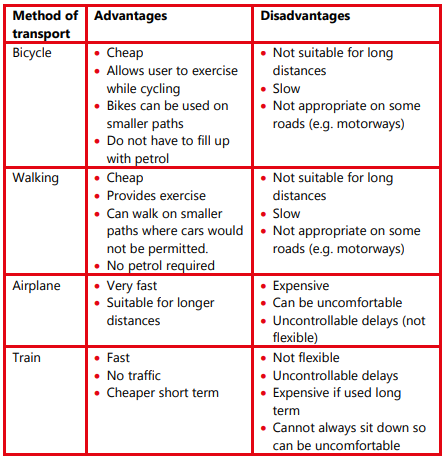
b) People travel more today than they did 100 years ago. Discuss whether modern society and technology require people to travel more or not.
▶️Answer/Explanation
Ans: Award marks for two valid points with explanations.
